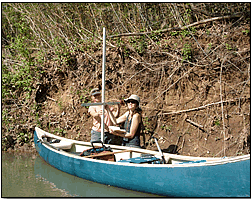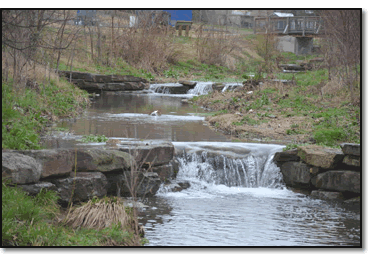
Storm water runoff
 There are all manner of things that negatively impact a waterway and it is easy to blame industry, agriculture, construction or sewage plants, but the biggest culprit is rain! Storm run-off fills the river with mud, gravel, toxins and debris from countless feeder streams that swell to torrents after rain. River banks are torn away. Gullies are cut into rural roads. Roofs of buildings and the acres of highway and car parks are washed clean of all their surface contamination that courses downhill to the river because there is nowhere else to go.
There are all manner of things that negatively impact a waterway and it is easy to blame industry, agriculture, construction or sewage plants, but the biggest culprit is rain! Storm run-off fills the river with mud, gravel, toxins and debris from countless feeder streams that swell to torrents after rain. River banks are torn away. Gullies are cut into rural roads. Roofs of buildings and the acres of highway and car parks are washed clean of all their surface contamination that courses downhill to the river because there is nowhere else to go.
We may be tempted to shrug and walk away from the problem because a rainstorm is just too big to handle. But wait! There’s a lot that we can do.
The road department driver who grades our gravel roads has science, engineering and ecology in mind as he (or she) contours the road to shed water off the sides instead of gouging channels into the surface. Side ditches are shaped every few yards to divert the flow to flat ground where it can soak away slowly instead of rushing headlong to the creek. And that’s a skill that individual property owners, businesses, schools and parks can copy.
Here are a few local examples:
Mercy Hospital in Berryville has a rain pond that gathers water from the entire roof system and the whole car park. The down-spouts from the roof connect to a system of pipes that run underground to the pond and the car park has a gentle tilt, sending surface water to the same pond. Not only is the pond an attractive feature that supports wildlife but it is maintenance-free and effective as a buffer for storm water.
The homeowner at 1180 Hwy 221 South of Berryville has built a classic rain pond that is visible from the road as you drive by. A small dam across the natural fall of the hillside captures water during the rainy season while excess rain trickles over the dam and onward to the creek. In summer it is a dry, grassy hollow.
Mill Creek Weirs built to mitigate storm water runoff at the Berryville Community Center.
 There used to be a gully through the parkland at the Berryville Community Center that was an eyesore. Storm water tore at the soil, blocking drains with branches, leaves and trash that cascaded down the slope. But a project two years ago led by the Kings River Watershed Partnership created a series of steps using natural stone and rock, holding the water in pools and irrigating the plant-life. A recent near-record rainstorm of 4 inches in just a few hours did not disturb this new waterway.
There used to be a gully through the parkland at the Berryville Community Center that was an eyesore. Storm water tore at the soil, blocking drains with branches, leaves and trash that cascaded down the slope. But a project two years ago led by the Kings River Watershed Partnership created a series of steps using natural stone and rock, holding the water in pools and irrigating the plant-life. A recent near-record rainstorm of 4 inches in just a few hours did not disturb this new waterway.
We can create our own water garden to prevent soil erosion and it doesn’t require a back-hoe or a Caterpillar tractor. A barrow and a few garden tools in the hands of enthusiastic people are all that is needed. The object is to excavate a dip in the ground with slightly higher ground round three sides and an open section to admit rain water. The slopes can be gentle enough to allow the mower to ride over yet retain the bulk of the surface water for a few hours after a storm. Shrubs and small trees may flourish in that dip, receiving more than their share of irrigation since the rain soaks deep into the ground instead of rushing across the surface. With a little enterprise, ingenuity and effort we can tame the storm waters and enhance our rivers.
Submitted by the board of the Kings River Watershed Partnership.
Measuring stream bank erosion on the Kings River
P.O. Box 961 | Berryville, AR 72616 | Phone: 870-480-8897 | Email: KRWP@kingsriverwatershed.org
Site Copyright © Kings River Watershed Partnership 2007-2023. All rights reserved.
Last Update April 2023